14 Tips For Making The Ultimate Quesadillas
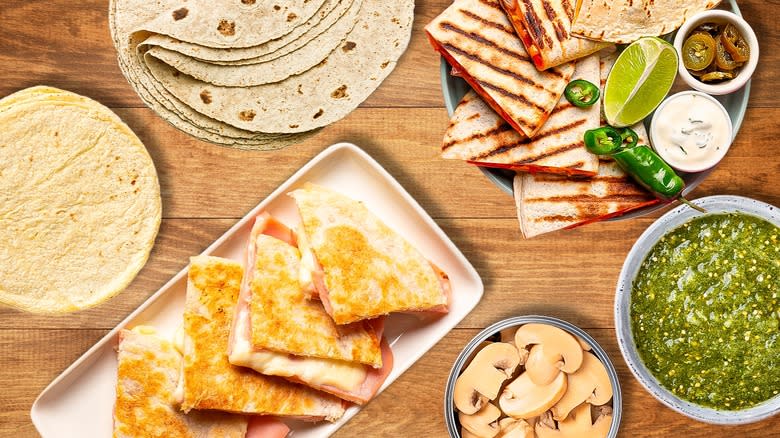
If you enjoy Mexican food, you've no doubt come across the quesadilla. This simple, flat, rich, and flavorful specialty consists of hot and crispy tortillas enveloping ingredients such as cheese, meats, vegetables, spices, and herbs. In its simplest form, it's only filled with cheese, which isn't surprising since the name of the dish is a portmanteau of the Spanish word for cheese (queso) and tortilla.
The quesadilla is a quintessential street food in Mexico, where the savory treat doesn't always include cheese but may feature regional foodstuffs ranging from chicken tinga to huitlacoche corn fungus. Over the years, especially after its surge in popularity across the United States, quesadilla ingredients have expanded to include not just classic cheeses and meats, but flavor and filling combinations as unique as the imaginations of those who create them.
You may have eaten delicious quesadillas at Mexican restaurants, but if you're new to making them at home, it's a good idea to understand the process before you get started. While quesadillas aren't difficult to make, there are a few common mistakes that can lead to undesirable results — like burned or soggy tortillas, tasteless or partially cooked fillings, or fillings that fall out when you pick up a slice. Luckily, we've compiled a few tips to help you make restaurant-quality quesadillas at home.
Read more: 30 Popular Frozen Pizzas, Ranked Worst To Best
Choose The Right Cheese
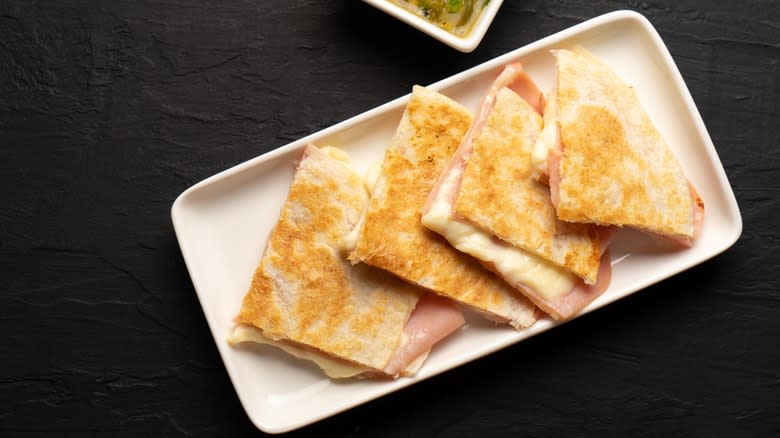
Choosing the wrong cheese is a mistake that can ruin quesadillas, but luckily there are many good options. If you're in doubt, Mexican cheeses are popular choices that work really well. Top choices are Oaxaca, Chihuahua, and asadero, which will taste closer to what you would get in Mexico. American-style quesadillas may include Monterey jack or mild cheddar. A quick and easy way to add some variety is to pick up a pre-shredded package of Mexican-blend cheeses at the supermarket.
What all the aforementioned cheeses have in common is they are very meltable. This is important for giving the finished quesadillas the right texture, with melted cheese dripping from the sides and acting as an adhesive to hold the other ingredients together (not to mention providing the pleasure of biting into rich, perfectly melted cheese).
There are many types of cheese out there, so if you'd rather experiment and choose your own, just remember to use ones that melt easily. In terms of taste, pick a milder cheese if you're planning on including strongly flavored ingredients.
Don't Worry About Corn Versus Flour Tortillas
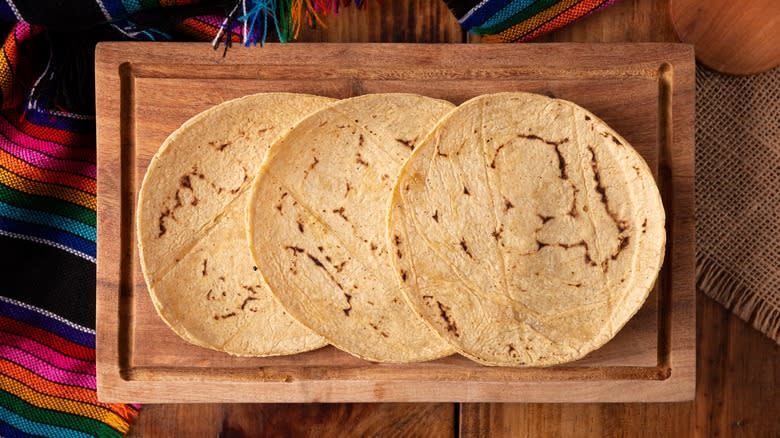
Many people won't hear of quesadillas made with anything other than flour tortillas, citing their softness and flexibility as musts. Meanwhile, other people are on team corn. Flour seems to be the standard in the U.S., but some corn tortilla advocates claim that their preference is more authentic. Indeed, the first tortillas were made from corn by pre-Columbian Native Americans, who were prolific maize farmers. However, while the origins of flour tortillas are unclear, this variety is predominant in areas of Northern Mexico close to the U.S. border, so they can also be considered authentically Mexican.
For the most part, the choice comes down to personal taste. Flour tortillas have a milder flavor and a fluffier texture, while corn tortillas have a drier consistency and a sharper flavor. However, corn tortillas may be the healthier option. When comparing the two types, corn tortillas have fewer calories and less fat, along with considerably less sodium and almost twice as much fiber as flour tortillas.
Know The Folded And Flat Cooking Methods
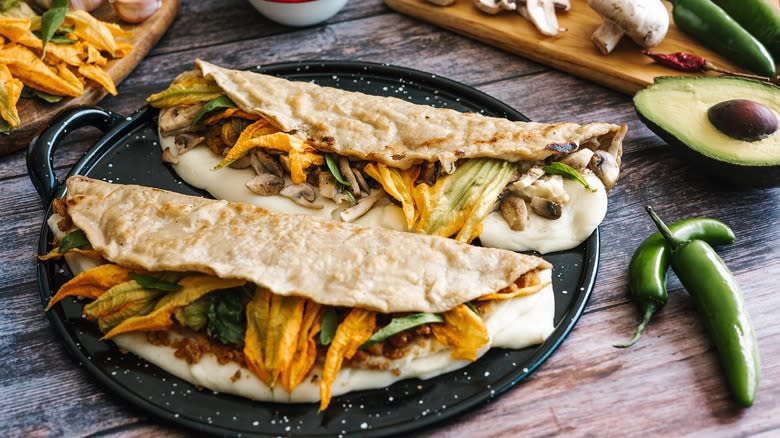
There are two ways to make a quesadilla. The first is the folded-tortilla method, also known as the half-moon style. You put one large tortilla in a hot pan, spread the fillings over the top side of it, and after the cheese is partly melted, fold the tortilla in half before flipping it to cook on both sides. The flat method requires two tortillas to sandwich the fillings in between, before flipping the entire double-tortilla quesadilla after the cheese has melted a little.
Which method to pick comes down to personal preference, and the kind of tortillas used. Fillings are less likely to spill out with the folded method, so this can be a neater choice. If you're new to the flat method, make sure that you don't overfill the quesadilla, because flipping this type may feel tricky, and fillings spilling out will only make it more difficult. Using very meltable cheese will also help to keep quesadillas together.
Flour tortillas can be used with both methods, although flipping larger flat quesadillas will be harder. Corn tortillas are more prone to cracking when they're folded, especially if they're not heated enough, which you don't have to worry about if using the flat-cooking method. The corn tortillas are also smaller, and thus easier to flip flat.
Use The Right Size And Quantities Of Filling
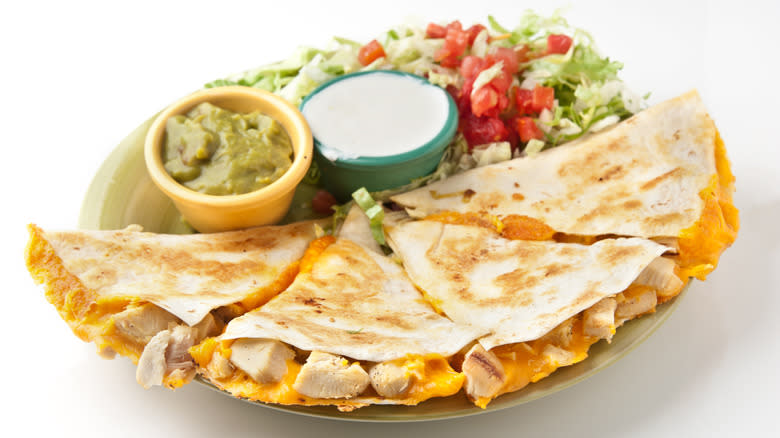
A golden tip for making quesadillas is to avoid overdoing it with fillings. It may be tempting to pile on delicious ingredients, but this will make the quesadilla hard to flip. Quesadillas are meant to be flat, so keep it light, limiting yourself to small amounts of fillings. Try to balance vegetable, meat, and cheese fillings evenly, and cut the ingredients into small pieces.
Consider shredding your meat and cheese to keep the pieces small and uniform, like in a shredded chicken quesadilla recipe. While larger pieces of cheese will at least partially melt, large pieces of meat (or plant-based options like tempeh) can easily fall out when working with the quesadillas. To be safe, consider pre-mixing shredded meat, chopped vegetables, and shredded cheese in a bowl before filling the tortillas.
While you don't want to overfill them, make sure you use enough cheese in your quesadillas, because otherwise the two halves won't stick together. There's nothing worse than a quesadilla that dumps its contents when you flip, slice, or bite into it. A final flipping tip is to leave a small border in between the filling and the edge of the tortilla to help the filling stay inside.
Use The Right Heat To Cook Quesadillas
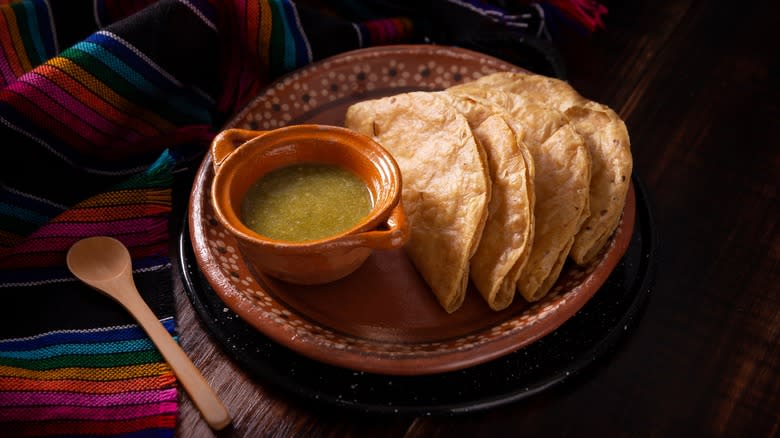
The ultimate quesadilla is cooked in a pan that's hot enough to create a solid sear on the outside, while the cheese and fillings are thoroughly heated on the inside. It can tricky to know when to cook quesadillas over medium or high heat, or to find the perfect sweet spot in between.
Generally, medium heat is recommended. Tortillas are thin, and the fillings are usually thicker, so you need a moderate amount of heat to cook both ingredients evenly. If the heat is too high, it will be all too easy to burn the surface before all the cheese melts and any vegetables on the inside get hot — a blackened tortilla with lukewarm fillings is not what we're going for.
You can sauté vegetables on medium-high, which is recommended so that their excess liquid evaporates, but turn the heat down to medium before adding the butter or oil that you'll cook the quesadillas in. Some pans will heat up more than others, so keep a close eye on the pan and lower the heat if the tortilla is getting too dark too soon.
Prevent Soggy Quesadillas
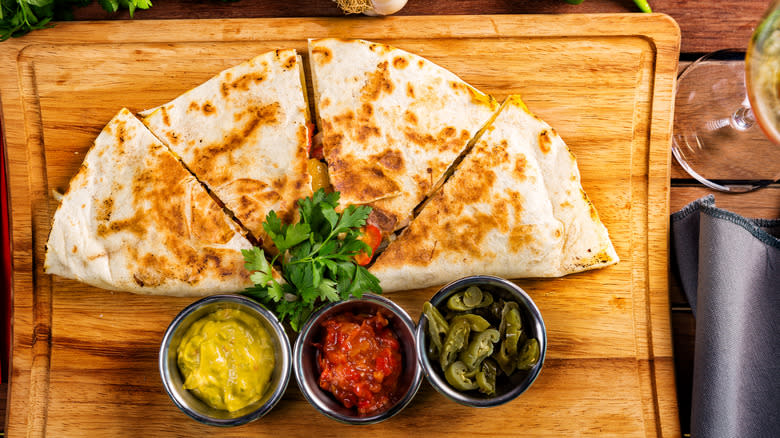
Soggy quesadillas are the stuff of nightmares, with fillings slipping out, liquid pooling on your plate, and half-empty slices dangling sadly from your hands. Avoid this scenario by following a few tips to ensure that your quesadillas are crispy.
Overly wet fillings like tomatoes are not recommended. Other vegetables like onions and bell peppers are commonly used, but cook them correctly before adding them to the tortilla so they don't bring excess liquid with them. Sauté them spread out in a large pan, so the water is evaporated out during the cooking process, and drain any excess liquid. Envelop meat and vegetable fillings between layers of shredded cheese to increase the cheese's adhesive properties. The layer of fat in the melted cheese will also keep wetter fillings from saturating the tortilla.
Heat oil or butter in a skillet on medium-high before adding the tortillas, so the tortillas can develop a crispy exterior. It's best to cook and eat quesadillas fresh from the stove, but if you need to reheat them, do so in the oven to preserve the contrast between the crunchy exterior and warm melted interior. If possible, avoid cooking them in the microwave, which makes quesadillas soft and soggy.
Flip Properly To Ensure Crispy Tortillas
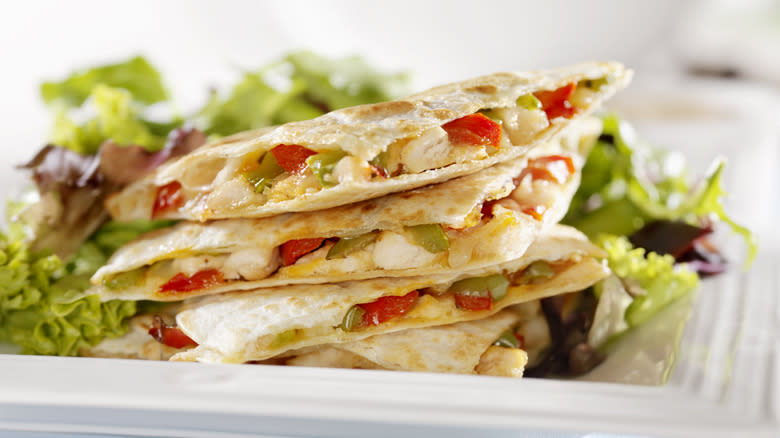
With the folded-quesadilla method, spread cheese across the top side of the tortilla before adding fillings, let the cheese partially melt, and then fold one half of the tortilla over the other half, pressing the top down with a spatula to help the melting cheese stick together. With the flat quesadilla method, spread the fillings over one tortilla, let the cheese melt somewhat, and then press a second tortilla on top of it. From that point on, the flipping process is similar for both styles.
The most important thing to remember is not to flip them too early, so that you don't get a floppy quesadilla with fillings falling out. Wait a few minutes until the heated tortilla develops a nice golden-brown, crispy surface, and the cheese has had some time to melt. Then carefully flip the quesadilla and cook the other side for a couple more minutes, until the cheese is completely melted and the other side is crispy and browned.
There's no consensus on whether butter or oil is best, but make sure to use one or the other. The hot fat helps the tortillas brown, and adds a rich, irresistible flavor. However, keep the amount of fat light, as too much oil can make the tortillas soggy. Some cooks prefer to rub a stick of butter directly on the outside of the tortillas before cooking, so as not to use too much.
Keep It Moving
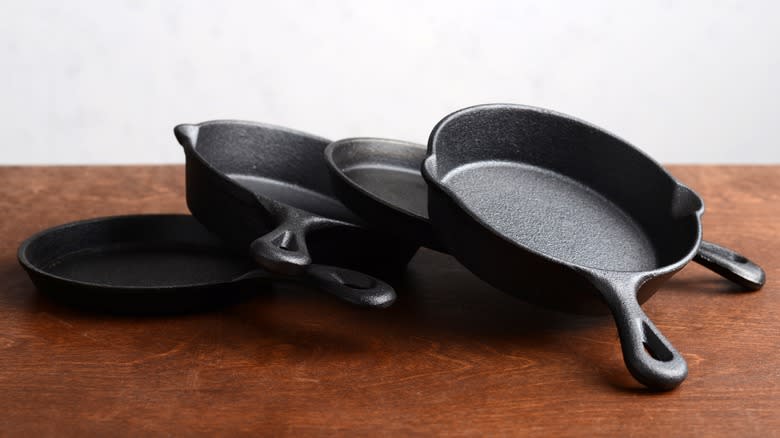
Quesadillas need to be cooked in a hot pan, and even if the heat is set to medium, they may burn if you're not careful. Some pans, like cast iron skillets, heat up more than others. Pans can also have hot spots, and if you're not using a heavy bottomed skillet, the pan may even tilt up on one end, causing one half of the pan to have more contact with the gas flame or electric burner. These scenarios can prevent the tortilla from cooking evenly.
There are a few things you can do to prevent burning or uneven browning. Check the underside of the quesadilla with a spatula while it's cooking. If some parts are getting browned faster than others, rotate the quesadilla with the spatula. While you shouldn't use too much oil or butter, do make sure you use enough so that all parts of the quesadilla fry and brown evenly in a thin layer of fat.
Try Other Quesadilla Cooking Methods
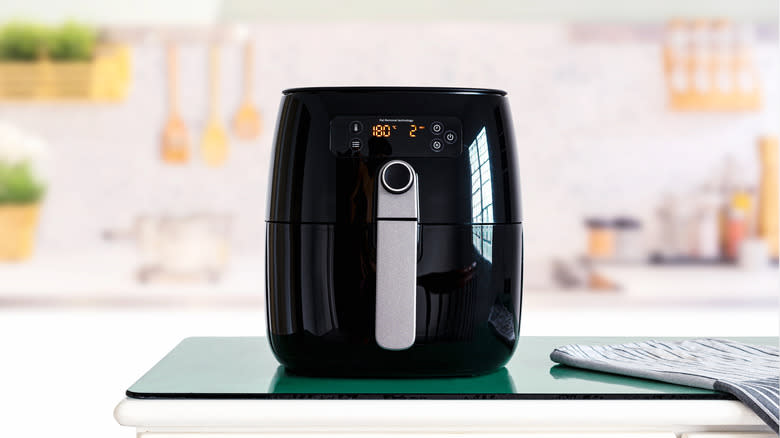
We've gone over how to cook a quesadilla in a skillet, which is the classic way, and this produces wonderful results. However, it's not the only option. You can also cook quesadillas in the oven.
This is a good idea if you're cooking for a crowd, because you can have a large batch ready at the same time rather than cooking them one at a time in a pan. Use the folded method to assemble the quesadillas on a greased baking sheet, and if necessary, hold the fold in place with a toothpick. (For safety reasons, soak the toothpicks in water before using them for cooking, and only use wooden ones.) You'll need to cook the quesadillas in the oven for longer — six to eight minutes per side, flipping halfway, until the surfaces are golden brown.
Another option is to make quesadillas in an air fryer for a quick and tasty weeknight meal. This method is not labor-intensive, and may be healthier. Assemble folded quesadillas in the air fryer basket, brushing both sides with oil (again, securing them with a toothpick if needed). Cook them on 350 F for six to eight minutes, and then flip and cook for three to five minutes more.
Be Creative With Ingredients
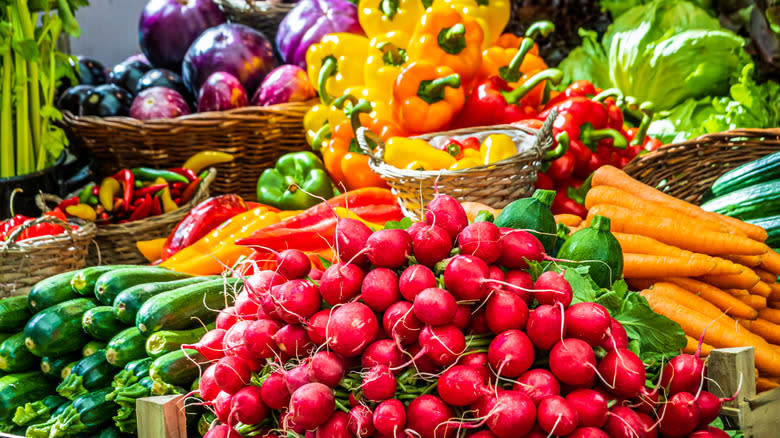
There are endless options for quesadilla ingredients, both traditional and non-traditional. Fillings can vary from plain cheese to a mix of complementary ingredients that include meat, beans, cheese, vegetables, herbs, and spices. You can even make breakfast quesadillas with scrambled eggs, or dessert quesadillas with chocolate and bananas.
Consider including some of the essential ingredients you need for Mexican cooking, like corn, squash blossoms, epazote, chile peppers, and beans. As for vegetables, nobody says you need to stop at onion and bell pepper. Make tasty versions with sweet potato, spinach, broccoli, mushrooms, or roasted vegetables, or try making a pumpkin quesadilla or a collard greens quesadilla for a unique twist.
While quesadillas traditionally include cheese, plant-based diners can choose hummus or other dairy-free cheese alternatives instead. Finally, don't forget flavorful ingredients like alliums and herbs. Onions, garlic, scallions, basil, oregano, mint, or cilantro could take your ingredient combination to the next level. Since quesadillas are filled individually and there are so many options, each member of a family or group can choose their own favorites for stuffing theirs, so everybody ends up happy.
Experiment With Protein
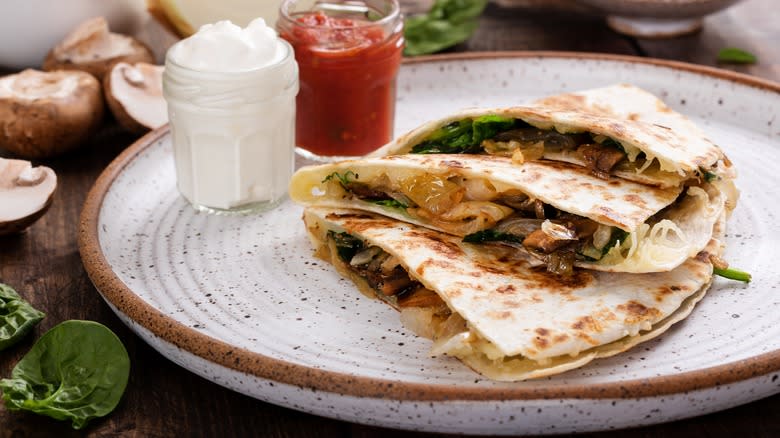
For many, a classic quesadilla with cheese is ideal, while other people prefer to include protein ingredients. If you're adding meat or fish — like in leftover pulled pork quesadillas or a crispy chicken quesadilla recipe — make sure you cook the protein first on its own. Adding raw meat is a recipe for disaster, and this goes for raw vegetables too, since they won't cook fast enough before the tortilla burns. The juices released during cooking will also make the quesadilla soggy.
As far as meat options, quesadillas can be made with steak, chicken, pulled pork, ground beef, bacon, and sausage, to name just a few possibilities. Shrimp and other shellfish like lobster or crab are good seafood options, and fish quesadillas made with firm-fleshed fish like tilapia or cod hold up great as well.
If you prefer a plant-based option, chickpeas are a good protein for meat-free quesadillas, as are any beans. Whether you leave them whole or mash them with a fork, chickpeas give this dish a healthy dose of protein, fiber, vitamins, and minerals, and their mild flavor is a blank slate for pairing with your favorite vegetables and spices.
Use A Complementary Dipping Sauce
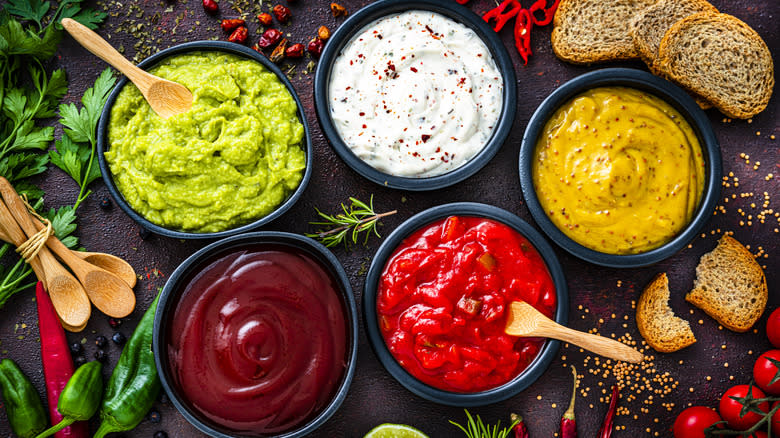
Quesadillas are delicious on their own, but they're often served with dipping sauces to provide extra flavor, and there are plenty of sauces to choose from. If you're cooking at home, you can plan dipping sauce options and quesadilla ingredient choices that complement each other, as seen in a recipe for steak quesadillas with guasacaca sauce. Guasacaca — a Venezuelan avocado-based condiment that includes onion, garlic, oil, vinegar, and cilantro — provides a cool and creamy contrast to the hot, crispy exterior of a quesadilla. Other options provide a similar contrast and are more easily found in stores, including classic guacamole or sour cream.
Pico de gallo can be made quickly at home with tomatoes, onion, cilantro, lime juice, and salt, and this salsa is often available pre-made in supermarkets. It imparts a bright and tangy taste, as well as a bit of texture as a dipping sauce or topping. Numerous varieties of salsa can easily be found in supermarkets, and they have the benefit of offering a lot of flavor without the fat content of creamier condiment choices. Salsa comes in different varieties, colors, and levels of heat to suit different tastes.
Hot Honey Gives Quesadillas A Sweet And Spicy Kick
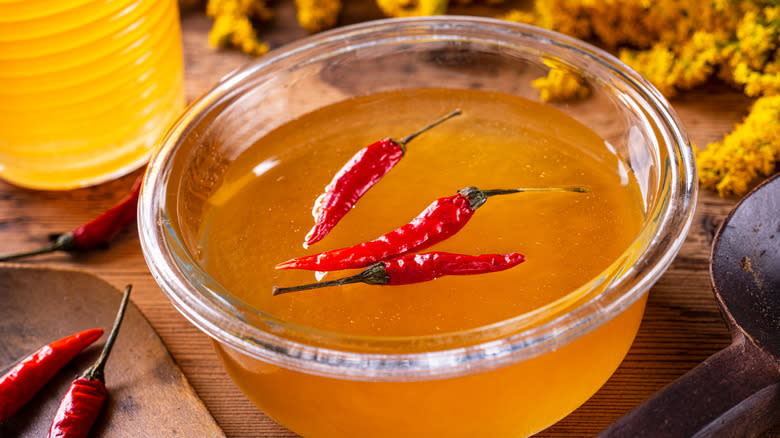
If you're looking for an unconventional-yet-tasty condiment to add, you may want to give your quesadillas a kick of sweet heat with hot honey. This spicy condiment mixes floral honey with hot peppers. The unexpected flavor combination is surprisingly enjoyable, and it's become a key player in a range of uses that are just as unexpected, including drizzling it on pizza, adding it to dressings, using it to enhance meats like fried chicken and burgers, and incorporating it in hot toddies, egg dishes, fruit salads, baklava, and even ice cream.
Quesadillas hail from Mexico, and one thing Mexican food is famous for is spiciness. Rather than relying on salsa or jalapeños to deliver the heat, consider hot honey to switch things up. Not only will it deliver spicy flavor, it will give quesadillas a nice touch of sweetness too, which can balance out the other tastes.
There are a few ways to use this special ingredient. You can drizzle it on top of quesadillas before serving them, spread it or drizzle it inside the tortillas when you're adding the filling, or serve it as a dipping sauce for a stronger flavor with each bite.
Make Your Own Tortillas
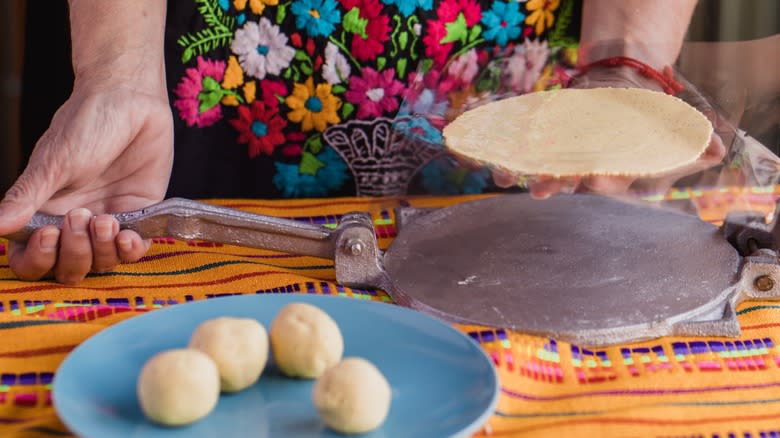
There's an open secret to preparing the most delicious tortillas ever — making them from scratch. If you have the time and inclination, or would like to try a fun new cooking project, this is a way to achieve a result that's a world apart from what's on the supermarket shelf. If the process feels intimidating, know that it takes just a few simple ingredients and one basic cooking method. You'll only need flour (wheat or corn), water, and salt. For flour tortillas, you'll also need a fat like lard, butter, or vegetable oil.
The best way to ensure fluffy homemade flour tortillas are to make sure the pan is at the right temperature, and to use flour with a protein content of 10% to 12%. Corn tortillas don't develop fluffy bubbles, but the basic cooking method is the same. And no, you don't need to invest in a tortilla press. As long as you didn't add too much water to the dough, which makes it sticky, forming the tortillas is effortless after a little practice. Just flatten out flour tortillas with a rolling pin, or press your corn tortilla dough balls with a heavy skillet or baking dish lined with plastic wrap.
Read the original article on Tasting Table

